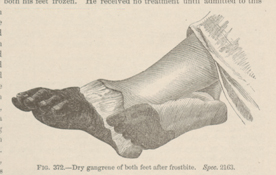Title: Schofield, R.
Source text: The Medical and Surgical History of the War of the Rebellion. (1861-65.), Part 3, Volume 2 (Washington, DC: Government Printing Office, 1883), 678-679.
Civil War Washington ID: med.d2e25599
TEI/XML: med.d2e25599.xml
CASE 1005.—Amputation of toes.—Hospital Steward R. Schofield. 69th Pennsylvania, aged 49 years, had both his feet frost-bitten while with his regiment in the field near Stevensburg, January 1, 1864. Surgeon R. B. Bontecou, U. S. V., in charge of Harewood Hospital, Washington, gives the following history: "The patient was a man of temperate habits and of good constitution. The tent in which he was sleeping in the field was blown down during the night, when his feet became exposed, the other parts of his body remaining well protected. Although the weather was intensely cold, he slept well during the night, and on waking up in the morning found the forepart of both his feet frozen. He received no treatment until admitted to this hospital on February 1st. At the time of his admission the patient was found to be suffering from dry gangrene of the toes of both feet, resulting from the freezing, and extending to the metatarsal bones of the left foot, with destruction of the soft parts. The patient was in good spirits, and although he was doing well it was deemed advisable to disarticulate the toes. Nourishing diet and stimulants were administered and simple dressings were used." The amputated toes, contributed to the Museum with the description of the case by Surgeon Bontecou, constitute specimen 2163 of the Surgical Section, and a representation of the diseased feet appears in the adjoining wood-cut (FIG. 372). The patient was discharged from service for disability January 27, 1865, and pensioned. The Philadelphia Examining Board on November 7, 1877, certified to the pensioner's condition as follows: "He has had all the toes of the right foot amputated through the metatarso-phalangeal articulation except the little toe, which is drawn into the cicatrix. The foot is defective in circulation and there are chronic ulcers of the leg extending from the ankle to within four and a half inches below the knee, being very offensive and requiring constant care and attention. This condition no doubt is due to anæsthesia of the foot and leg. The cicatrices extend around the leg and are constantly sealing. There is also varix above to a slight extent. The toes of the left foot were amputated at the tarso-metatarsal articulation, the stump showing a good horny cicatrix; hyperæsthesia of foot or stump; atrophy of leg; stump alleged to be painful during changes of weather," etc. The pensioner was paid September 4, 1881.
